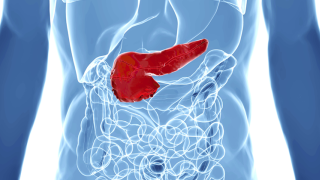Researchers led by Ajay Goel, Ph.D., M.S., founding chair of the Department of Molecular Diagnostics and Experimental Therapeutics and founding director of Biotech Innovations at Beckman Research Institute of City of Hope, have developed two new tests for assessing risk levels in people with pancreatic ductal adenocarcinoma, or PDAC. Such tests could lead to better personalized care for these patients and, therefore, potentially improved outcomes.
Pancreatic cancer is a very difficult disease that is hard to treat, and PDAC accounts for the vast majority of pancreatic malignancies. In last 40 to 50 years survival rates have improved only slightly, but the five-year survival rate is still under 10%, says Goel. Part of the reason is that clinicians do not currently have robust tools to assess whether a patient is high risk, meaning they are more likely to have poor treatment outcomes, versus low risk, which means they are more likely to respond well to therapies.
“We are learning that there are different subsets of pancreatic cancers and that those with poor outcomes have identifiable high-risk features,” said Goel. “If you know upfront who are the high-risk patients, we can manage their care differently. So, we are attacking the disease in a multiprong fashion and hopefully can offer a small subset of patients longer survival times, better care and more precision oncology treatments.”
Investigating the Tumor Microenvironment
In recent papers, Goel and colleagues outlined two methods for finding biomarkers that correlate with higher risk in PDAC patients. The first study, published online on March 31, 2020, in Clinical Cancer Research, examined the tumor microenvironment, which helps tumors thrive and plays a large role in the poor outcomes associated with PDAC. The tumor microenvironment in PDAC is highly fibrotic, full of connective tissues and blood vessels, or stroma. This stromal barrier makes drug delivery very difficult and is why many treatments do not work.
“The tumor microenvironment presents a challenge to developing effective therapies that can permeate complex fibrotic stroma within PDAC,” explained Goel. “So, we purposefully focused this test to interrogate the three most important cell types in PDAC microenvironment: stromal genes, immune signatures and proliferation genes, which allow cancers to grow.”
Through this effort, the team was able to identify a 15-gene immune, stromal and proliferation gene signature that significantly associated with poor overall survival.
“It’s a unique feature of our new test that we use these three categories of biomarkers to develop a panel that now gives us a lot more confidence in finding high-risk patients,” said Goel.
Looking for Clues in Micro-RNAs
In a second study, published May 8 in the Annals of Surgery, Goel and colleagues were able to generate a panel of micro-RNAs, or very small RNA molecules, that can give clinicians information about a patient’s risk level before that person is treated for PDAC. The micro-RNAs they identified control the expression of candidate genes within the PDAC subtypes that are known to have poor outcomes.
“If we simply go by pathological or evidence-based data that we have before we do any biopsy or surgery, those are very unreliable,” explained Goel. “Having a molecular marker that can be measured in blood prior to any treatment would probably help us stratify these patients much more effectively. No one has ever looked for micro-RNA biomarkers in blood before; we are the first to attempt it.”
The experimental testing for the Annals of Surgery paper was all done in tissue samples, but because micro-RNAs can be easily measured in blood, Goel says the study results represent the exciting potential to be translated into a noninvasive prognostic and potentially even a disease-monitoring blood-based biomarker test for PDAC patients.
Both of the recent studies were retrospective in nature, so the researchers already knew the patient’s diagnosis and outcome. Next, in order for Goel and his colleagues to move these tests into the clinic, they are in the process of validating the biomarkers they’ve identified in prospective settings. This means they will collect samples from patients who visit their clinics now, and in the future, to ensure that they can make solid predictions based on these markers.
The team is also trying to convert the tissue-based miRNA biomarker test into a noninvasive, blood-based biomarker test. The eventual goal would be to completely eliminate the need for biopsies and just use a blood-based (liquid biopsy) test for both diagnosis and prognosis of PDAC down the line.
“We need to consider on-the-ground reality,” Goel said. “Rather than looking at pancreatic cancer as a whole, we are looking at the key mechanisms that play a role, which I think is leading us to more sophisticated and focused markers in terms of the prognosis and risk in pancreatic cancer patients. We aren’t going to rescue all of them, but it’s a tough disease so even if you can help, 5, 10, 15% of patients prolong their survival, that would be a huge victory.”
Gagandeep Singh, M.D., liver and pancreas surgeon at City of Hope and head of the hepatobiliary and pancreatic surgery service, was a co-author on the Clinical Cancer Research paper, “A 15-gene immune, stromal and proliferation gene signature that significantly associates with poor survival in patients with pancreatic ductal adenocarcinoma,” along with researchers from the Charles A. Sammons Cancer Center at Baylor University Medical Center in Dallas, Osaka University Graduate School of Medicine in Osaka, Japan, and Kumamoto University Graduate School of Medical Sciences in Kumamoto, Japan. The Annals of Surgery paper, “Identification of serum miRNA signature and establishment of a nomogram for risk-stratification in patients with pancreatic ductal adenocarcinoma,” involved researchers from across the U.S. and Asia.

